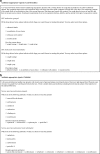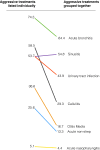Nudging physician prescription decisions by partitioning the order set: results of a vignette-based study
- PMID: 25394536
- PMCID: PMC4351289
- DOI: 10.1007/s11606-014-3051-2
Nudging physician prescription decisions by partitioning the order set: results of a vignette-based study
Abstract
Background: Healthcare professionals are rapidly adopting electronic health records (EHRs). Within EHRs, seemingly innocuous menu design configurations can influence provider decisions for better or worse.
Objective: The purpose of this study was to examine whether the grouping of menu items systematically affects prescribing practices among primary care providers.
Participants: We surveyed 166 primary care providers in a research network of practices in the greater Chicago area, of whom 84 responded (51% response rate). Respondents and non-respondents were similar on all observable dimensions except that respondents were more likely to work in an academic setting.
Design: The questionnaire consisted of seven clinical vignettes. Each vignette described typical signs and symptoms for acute respiratory infections, and providers chose treatments from a menu of options. For each vignette, providers were randomly assigned to one of two menu partitions. For antibiotic-inappropriate vignettes, the treatment menu either listed over-the-counter (OTC) medications individually while grouping prescriptions together, or displayed the reverse partition. For antibiotic-appropriate vignettes, the treatment menu either listed narrow-spectrum antibiotics individually while grouping broad-spectrum antibiotics, or displayed the reverse partition.
Main measures: The main outcome was provider treatment choice. For antibiotic-inappropriate vignettes, we categorized responses as prescription drugs or OTC-only options. For antibiotic-appropriate vignettes, we categorized responses as broad- or narrow-spectrum antibiotics.
Key results: Across vignettes, there was an 11.5 percentage point reduction in choosing aggressive treatment options (e.g., broad-spectrum antibiotics) when aggressive options were grouped compared to when those same options were listed individually (95% CI: 2.9 to 20.1%; p = .008).
Conclusions: Provider treatment choice appears to be influenced by the grouping of menu options, suggesting that the layout of EHR order sets is not an arbitrary exercise. The careful crafting of EHR order sets can serve as an important opportunity to improve patient care without constraining physicians' ability to prescribe what they believe is best for their patients.
Figures
Comment in
-
Capsule commentary on Tannenbaum et al., nudging physician prescription decisions by partitioning the order set: results of a vignette-based study.J Gen Intern Med. 2015 Mar;30(3):343. doi: 10.1007/s11606-014-3095-3. J Gen Intern Med. 2015. PMID: 25533389 Free PMC article. No abstract available.
References
-
- Slovic P. The construction of preference. Amer Psych. 1995;50(5):364–371. doi: 10.1037/0003-066X.50.5.364. - DOI
Publication types
MeSH terms
Grants and funding
LinkOut - more resources
Full Text Sources
Other Literature Sources



